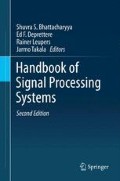Abstract
In many signal processing applications, the tokens in a stream of tokens have a dimension higher than one. For example, the tokens in a video stream represent images so that a video application is actually three- or four-dimensional: Two dimensions are required in order to describe the pixel coordinates, one dimension indexes the different color components, and the time finally corresponds to the last dimension. Static multidimensional (MD) streaming applications can be modeled using one-dimensional dataflow graphs[7], but these are at best cyclostatic dataflow graphs, often with many phases in the actor’s vector valued token production and consumption patterns. These models incur a high control overhead. Furthermore such a notation hides many important algorithm properties such as inherent data parallelism, fine grained data dependencies and thus required memory sizes. Finally, the model is very implementation specific in that some of the degrees of freedom such as the processing order are already nailed down and cannot be changed easily without completely recreating the model.
Access this chapter
Tax calculation will be finalised at checkout
Purchases are for personal use only
Notes
- 1.
This restriction will be released in Sect. 7.
- 2.
For more than two dimensions, see [12].
- 3.
Note that this relation will be broken in Sect. 7
- 4.
Section 3 introduced a processing order to enumerate sample points that are not part of a rectangular grid. This section differs in that it considers rectangular instead of arbitrary sampling patterns. The defined processing orders are hence purely to describe the application behavior, and are not a prerequisite for the balance equation.
- 5.
For Fig. 10b, a first level block with two rows and one column generates the desired processing order.
- 6.
- 7.
- 8.
Now Thales.
References
Piplib. http://www.piplib.org/
Bhattacharyya, S.S., Deprettere, E.F., Theelen, B.: Dynamic dataflow graphs. In: S.S. Bhattacharyya, E.F. Deprettere, R. Leupers, J. Takala (eds.) Handbook of Signal Processing Systems, second edn. Springer (2013)
Dumont, P., Boulet, P.: Another multidimensional synchronous dataflow: Simulating Array-OL in Ptolemy II. Tech. Rep. 5516, Institut National de Recherche en Informatique et en Automatique, Cité Scientifique, 59 655 Villeneuve d’Ascq Cedex (2005)
Falk, J., Haubelt, C., Zebelein, C., Teich, J.: Integrated modeling using finite state machines and dataflow graphs. In: S.S. Bhattacharyya, E.F. Deprettere, R. Leupers, J. Takala (eds.) Handbook of Signal Processing Systems, second edn. Springer (2013)
Gamatié, A., Rutten, E., Yu, H., Boulet, P., Dekeyser, J.L.: Synchronous modeling and analysis of data intensive applications. EURASIP Journal on Embedded Systems 2008(561863), 1–22 (2008). DOI 10.1155/2008/561863
Geilen, M., Basten, T.: Kahn process networks and a reactive extension. In: S.S. Bhattacharyya, E.F. Deprettere, R. Leupers, J. Takala (eds.) Handbook of Signal Processing Systems, second edn. Springer (2013)
Ha, S., Oh, H.: Decidable dataflow models for signal processing: Synchronous dataflow and its extensions. In: S.S. Bhattacharyya, E.F. Deprettere, R. Leupers, J. Takala (eds.) Handbook of Signal Processing Systems, second edn. Springer (2013)
ILOG: cplex. http://www.ilog.com/products/cplex/
ISO/IEC JTC1/SC29/WG1: JPEG2000 Part I final committee draft version 1.0 (2002). N1646R
Keinert, J., Deprettere, E.F.: Multidimensional dataflow graphs. In: S.S. Bhattacharyya, E.F. Deprettere, R. Leupers, J. Takala (eds.) Handbook of Signal Processing Systems, second edn. Springer (2013)
Keinert, J., Falk, J., Haubelt, C., Teich, J.: Actor-oriented modeling and simulation of sliding window image processing algorithms. In: Proceedings of the 2007 IEEE/ACM/IFIP Workshop of Embedded Systems for Real-Time Multimedia (ESTIMEDIA 2007), pp. 113–118 (2007)
Keinert, J., Teich, J.: Design of Image Processing Embedded Systems Using Multidimensional Data Flow. Springer (2011)
Murthy, P.K.: Scheduling techniques for synchronous and multidimensional synchronous dataflow. Memorandum no. ucb/erl m96/79, Electronics Research Laboratory, College of Engineering, University of California, Berkeley (1996)
Murthy, P.K., Lee, E.A.: Multidimensional synchronous dataflow. IEEE Transactions on Signal Processing 50(8), 2064–2079 (2002)
Vainio, O.: Mixed signal techniques. In: S.S. Bhattacharyya, E.F. Deprettere, R. Leupers, J. Takala (eds.) Handbook of Signal Processing Systems, second edn. Springer (2013)
Verdoolaege, S.: Polyhedral process networks. In: S.S. Bhattacharyya, E.F. Deprettere, R. Leupers, J. Takala (eds.) Handbook of Signal Processing Systems, second edn. Springer (2013)
Yu, H., Leeser, M.: Automatic sliding window operation optimization for FPGA-based computing boards. In: Proceedings of the 14th Annual IEEE Symposium on Field-Programmable Custom Computing Machines (FCCM ’06), pp. 76–88. IEEE Computer Society, Washington, DC, USA (2006)
Author information
Authors and Affiliations
Corresponding author
Editor information
Editors and Affiliations
Rights and permissions
Copyright information
© 2013 Springer Science+Business Media, LLC
About this chapter
Cite this chapter
Keinert, J., Deprettere, E.F. (2013). Multidimensional Dataflow Graphs. In: Bhattacharyya, S., Deprettere, E., Leupers, R., Takala, J. (eds) Handbook of Signal Processing Systems. Springer, New York, NY. https://doi.org/10.1007/978-1-4614-6859-2_35
Download citation
DOI: https://doi.org/10.1007/978-1-4614-6859-2_35
Published:
Publisher Name: Springer, New York, NY
Print ISBN: 978-1-4614-6858-5
Online ISBN: 978-1-4614-6859-2
eBook Packages: EngineeringEngineering (R0)

